

Helpful tips. Youth health. Youth Health is the range of approaches to preventing, detecting or treating young people’s health and well being (WHO, 2001).
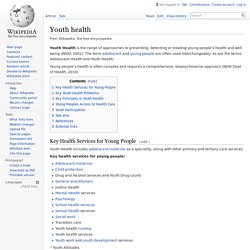
The term adolescent and young people are often used interchangeably, as are the terms Adolescent Health and Youth Health. Young people’s health is often complex and requires a comprehensive, biopsychosocial approach (NSW Dept of Health, 2010). Key Health Services for Young People[edit] Youth Health includes adolescent medicine as a speciality, along with other primary and tertiary care services. Key health services for young people: ^Youth Attitudes Web based supports such as Reach Out! Capacity building organisations support the Youth Health sector by providing access to information and resources, conducting research and providing training. Key Youth Health Problems[edit] Some young people engage in risky behaviours that affect their health and therefore the majority of health problems are psychosocial. Key Principles in Youth Health[edit] 1. Youth Participation[edit] Doping in sport. In competitive sports, doping refers to the use of banned athletic performance-enhancing drugs by athletic competitors, where the term doping is widely used by organizations that regulate sporting competitions.
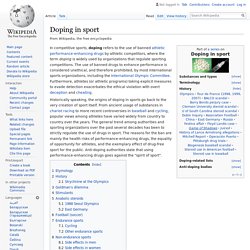
The use of banned drugs to enhance performance is considered unethical, and therefore prohibited, by most international sports organizations, including the International Olympic Committee. Furthermore, athletes (or athletic programs) taking explicit measures to evade detection exacerbates the ethical violation with overt deception and cheating. Historically speaking, the origins of doping in sports go back to the very creation of sport itself.
From ancient usage of substances in chariot racing to more recent controversies in baseball and cycling, popular views among athletes have varied widely from country to country over the years. Etymology[edit] There are many suggestions as to the origin of the term doping. History[edit] The American specialist in doping, Max M. [edit] [edit] NIDA for Teens. Alcohol and other drugs. Ecstasy - Drug Prevention & Alcohol Facts. What is ecstasy?
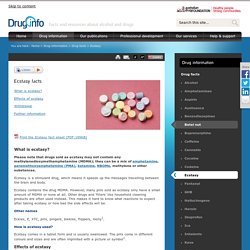
Effects of ecstasy Withdrawal Further information What is ecstasy? Please note that drugs sold as ecstasy may not contain any methylenedioxymethamphetamine (MDMA); they can be a mix of amphetamine, paramethoxyamphetamine (PMA), ketamine, NBOMe, methylone or other substances. Ecstasy is a stimulant drug, which means it speeds up the messages travelling between the brain and body.
Ecstasy contains the drug MDMA. National Institute on Drug Abuse (NIDA) Drug info @ your library. Methamphetamine: MedlinePlus. National Library of Medicine - National Institutes of Health. 03 teens alcohol and other drugs. 2008. Youth is a stage of life characterised by rapid psychological and physical transition, where young people progress from being dependent children to independent adults.
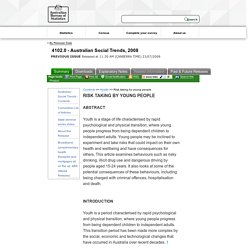
Young people may be inclined to experiment and take risks that could impact on their own health and wellbeing and have consequences for others. This article examines behaviours such as risky drinking, illicit drug use and dangerous driving by people aged 15-24 years. It also looks at some of the potential consequences of these behaviours, including being charged with criminal offences, hospitalisation and death. Youth is a period characterised by rapid psychological and physical transition, where young people progress from being dependent children to independent adults. This transition period has been made more complex by the social, economic and technological changes that have occurred in Australia over recent decades. 1 In 2007, there were 2.9 million people aged 15-24 years, making up 14% of the total population. Mentoring Reduces Risk Taking Behaviour in Teens – Yes! Youth Empowerment, Parenting And Mentoring for Schools, Parents, Teachers.
If someone were to ask you to recall an outrageous or just plain dangerous thing that you did as a teenager, I can almost guarantee that you could remember at least one event that makes you cringe.
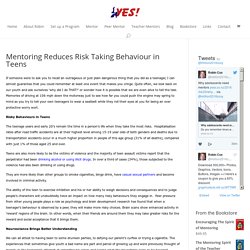
Quite often, we look back on our youth and ask ourselves ‘why did I do THAT?’ Or wonder how it is possible that we are even alive to tell the tale. Memories of driving at 106 mph down the motorway just to see how far you could push the engine may spring to mind as you try to tell your own teenagers to wear a seatbelt while they roll their eyes at you for being an over protective worry wort. Risky Behaviours in Teens The teenage years and early 20’s remain the time in a person’s life when they take the most risks. Teens are also more likely to be the victims of violence and the majority of teen assault victims report that the perpetrator had been drinking alcohol or using illicit drugs. Neuroscience Brings Better Understanding Mentoring Reduces Risk Taking Behaviour Sources: What Are "Blood Doping" and Erythropoietin (EPO)? - Drug Use in Sports - ProCon.org.
Performance-Enhancing Drugs, Anabolic Steroids, Steroid Use in Sports - The National Center For Drug Free Sport, Inc. - Human Growth Hormone (hGH) performance enhancing substance explained. What is Human Growth Hormone?
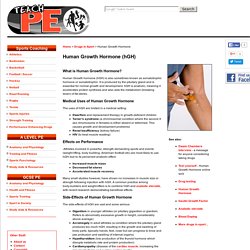
Human Growth hormone (hGH) is also sometimes known as somatotrophic hormone or somatotrophin. It is produced by the pituitary gland and is essential for normal growth and development. hGH is anabolic, meaning it accelerates protein synthesis and also aids the metabolism (breaking down) of fat stores. Medical Uses of Human Growth Hormone The uses of hGH are limited in a medical setting: Dwarfism and replacement therapy in growth-deficient children Turner's syndrome (a chromosomal condition where the second X sex chromosome in females is either absent or deformed. Effects on Performance .Athletes involved in powerful, strength demanding sports and events (weight lifting, body building, American football etc) are most likely to use hGH due to its perceived anabolic effect: Increased muscle mass Decreased fat stores Accelerated muscle recovery Many small studies however, have shown no increases in muscle size or strength following injection with hGH.
Test Yourself: Drug Testing Services, Drug Screening Policy Development, Drugs in Sports, Drug-Use Education Programs - The National Center For Drug Free Sport, Inc. Mind: The Science, Art and Experience of Our Inner Lives. Home - Australian Drug Foundation. Australian Institute of Criminology - Drug use. Drug Services - Alcohol and drug search directory. Risky Health Issues for Teens. National Institute on Drug Abuse (NIDA) Why the Teen Brain Is Drawn to Risk.
If you’re the parent of a tween, be warned: your cautious 10-year-old is bound to turn into a wild child in a few short years, with seemingly no regard whatsoever for safety.

Indeed, teenagers have the double the risk of dying compared to their preteen selves. Adults have long reckoned with ways to protect adolescents from their own misjudgments. Only recently, however, have researchers really begun to understand how the teen brain is wired and that some of what appear to be teens’ senseless choices may result from biological tendencies that also prime their brains to learn and be flexible.
Take teens’ perception of risk. It’s certainly different from that of adults, but not in the ways you’d expect. Risky Business: Why Teens Need Risk to Thrive and Grow. Erythropoietin EPO explained. Erythropoietin (often shortened to EPO) is a naturally occurring hormone, secreted by the kidneys, whose function is to regulate red blood cell production.
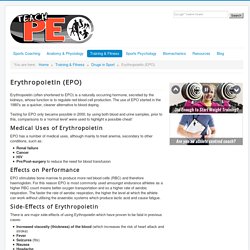
The use of EPO started in the 1980's as a quicker, cleaner alternative to blood doping. Testing for EPO only became possible in 2000, by using both blood and urine samples, prior to this, comparisons to a 'normal level' were used to highlight a possible cheat! Performance-enhancing drugs: Know the risks. Performance-enhancing drugs: Know the risks Are you hoping to gain a competitive edge by taking muscle-building supplements or other performance-enhancing drugs?
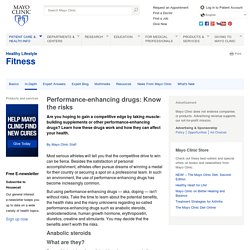
Learn how these drugs work and how they can affect your health. By Mayo Clinic Staff Most serious athletes will tell you that the competitive drive to win can be fierce. Besides the satisfaction of personal accomplishment, athletes often pursue dreams of winning a medal for their country or securing a spot on a professional team. But using performance-enhancing drugs — aka, doping — isn't without risks. Anabolic steroids What are they? Some athletes take a form of steroids — known as anabolic-androgen steroids or just anabolic steroids — to increase their muscle mass and strength.
Testosterone has two main effects on your body: Anabolic effects promote muscle building. Some athletes take straight testosterone to boost their performance. Drugs in Sport. Brent S.
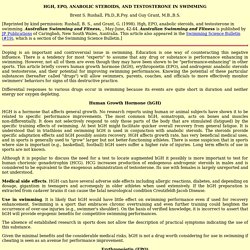
Rushall, Ph.D. ,R.Psy. and Guy Grant, M.B. ,B.S. [Reprinted by kind permission: Rushall, B. S., and Grant, G. (1998). Performance Enhancing Drugs (PEDs) in Sports. Performance enhancing drugs consist of a variety of substances, including medications, procedures and even devices that are intended to improve athletic sports performance. Some of these substances are naturally occurring, easily available and completely legal while others are manufactured, illegal, or banned by many sporting organizations.
Many athletes, coaches, politicians and fans feel the use of certain substances is unethical in sports.